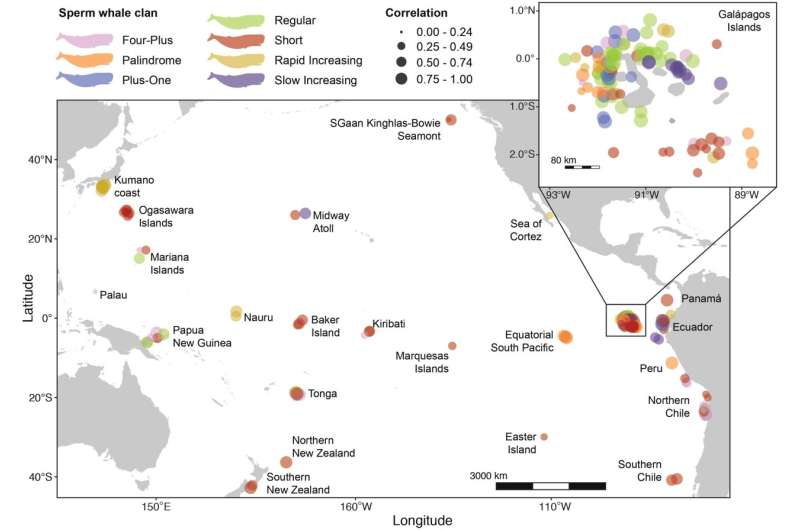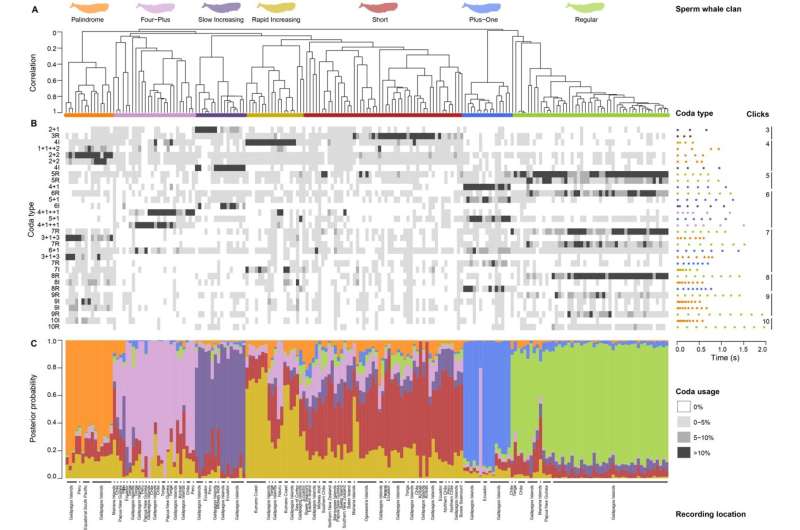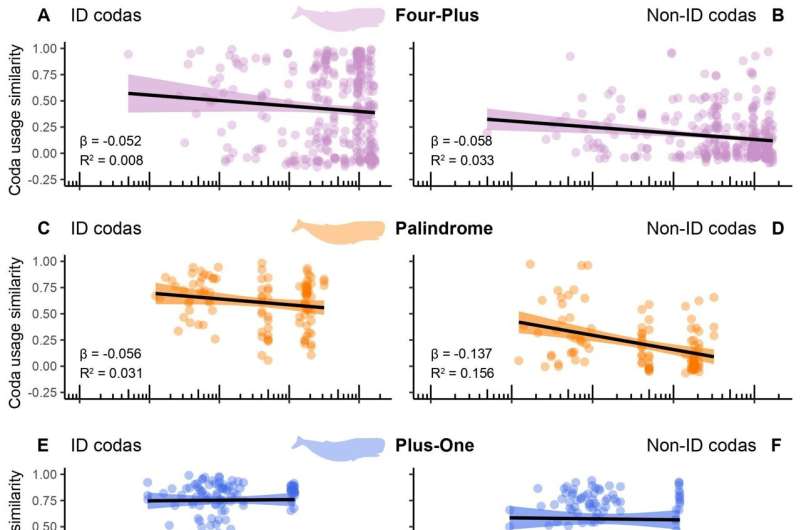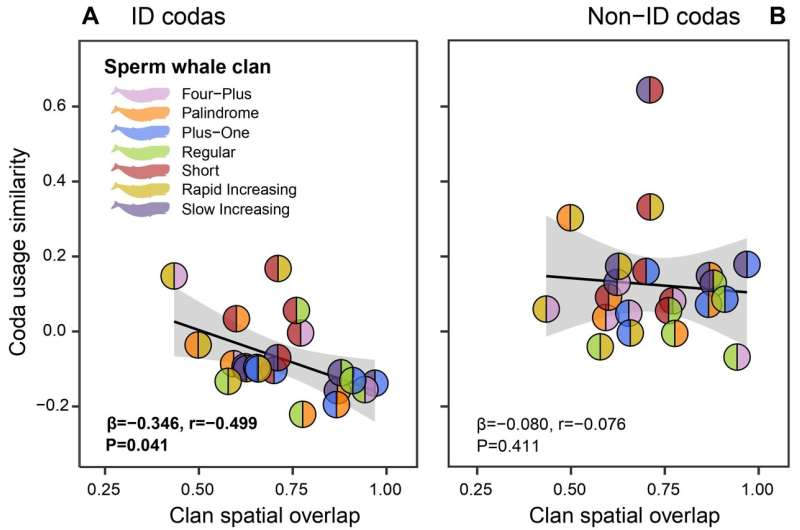Fig. 1. Composite map of sperm whale clan distribution across 23 labeled regions in the Pacific Ocean using the seven-clan tree clan designations. Each point is a single repertoire, colored by clan. Point size indicates the within-clan correlation of that repertoire, with smaller points having lower correlations. The scale bar is approximate and most accurate along the Equator. Credit: Taylor Hersh - Max Planck Institute for Psycholinguistics
For decades, researchers and the public have been captivated by the deep-diving sperm whales, highly social animals who live in groups of mothers and calves. The whales communicate with Morse code-like series of clicks called codas, and whales that use similar coda "dialects" belong to the same cultural group or vocal clan. Sperm whale researchers have long suspected that whales use certain coda types to distinguish vocal clans. But previous studies of sperm whale clans were largely region-specific.
"This work was the culmination of decades of research efforts by individuals working throughout the Pacific Ocean," says first author Taylor Hersh. "We decided to share data and work collaboratively, to learn something new about this enigmatic, charismatic and cultural animal."
Clan identity
The team set out to investigate whether certain sperm whale codas are similar to human ethnic markers—such as dialects or clothing styles. They were specifically interested in "identity codas"; coda types that are particular to a clan, rather than common across clans.
Could such codas be symbolic markers of sperm whale clan identity? If so, they might mirror human patterns, where cultural groups are most marked or distinguishable in regions where multiple groups overlap—perhaps to better signal their group identity. In the same way, sperm whales may rely on identity codas more in areas with multiple overlapping clans.
"Whales from different clans never interact with each other, even when they share the same waters," explains Hersh. "This suggests that the whales have some way of distinguishing 'us' vs. 'them,' and we wanted to know if they do so using identity codas."
Fig. 2. Seven-clan tree with identity coda types (constructed in IDcall using critfact = 5 and minrep = 15). (A) Average linkage hierarchical clustering dendrogram depicts similarity among sperm whale coda repertoires recorded across the Pacific Ocean. Repertoires that are more similar, in terms of coda type usage, cluster closer together and have a higher correlation value (y axis). (B) Heat map depicts identity coda type usage (rows) for each repertoire (columns) in shades of gray. Usage is calculated based on probabilistic assignment of codas to types. Identity coda type names are on the left and type centroid rhythm plots (colored by clan) are on the right of the heat map (each dot represents a click). (C) Stacked bar plot shows the posterior probabilities of repertoire assignations to clans. Recording locations are listed along the bottom. Credit: Taylor Hersh - Max Planck Institute for Psycholinguistics
Pacific Ocean sperm whales
An international team of 27 researchers studying Pacific Ocean sperm whales pooled their acoustic datasets. This way, the team could investigate click patterns across 23 locations, from Canada to New Zealand and Japan to South America. For some locations, they still needed to extract codas from the whale recordings. This was done as part of the "Global Coda Dialect Project" led by Shane Gero (overall project and Atlantic Ocean lead), Hersh (Pacific Ocean lead), and Chris Johnson (Indian Ocean lead).
The Pacific Ocean team extracted more than 23,000 codas. Next, they determined how many of those were used as identity codas by whale clans, with a method previously developed by Hersh and colleagues.
The team identified seven sperm whale vocal clans across the Pacific Ocean, each with their own dialect and identity codas. The whale dialects followed the pattern predicted from human culture. As spatial overlap between clans increased, their dialects in terms of identity coda usage became more distinct.
Fig. 3. Logged geographic distance vs. coda usage similarity for each clan, calculated using identity codas (simIDwi; left panels, A/C/E/G/I/K/M) or nonidentity codas (simnonIDwi; right panels, B/D/F/H/J/L/N) within a clan. Each circle represents a pair of coda repertoires. For each panel, the regression line slope (β) and R2 value are provided. The 95% CIs are shaded. Credit: Taylor Hersh - Max Planck Institute for Psycholinguistics
Non-human cultures
Knowing about the culture of non-human animals is important for conservation efforts. According to Hersh, the findings also point towards similarities between human and non-human cultures. "Our results demonstrate how culture can structure animal populations. The conditions required for the evolution of symbolic markers of cultural identity exist among non-human animals as well."
"Past research on vocal clans has shown that they not only differ in the codas they use, but also in how they move, forage, and socialize. This matches another human ethnic marker prediction that symbolic marker and social norm distributions should correspond. However, we know very little about the social norms and 'lifestyles' of several of the Pacific Ocean sperm whale clans documented here, and hope to study their behavior more in the future. While the present work focused on the Pacific Ocean, we plan to extend our analyses to sperm whales in the Atlantic and Indian Oceans too."
Fig. 4. Mean clan spatial overlap vs. coda usage similarity, calculated using identity codas (simIDbt; A) or nonidentity codas (simnonIDbt; B). Each circle represents a pair of clans. For each panel, the regression line slope (β), Mantel test matrix correlation coefficient (r), and Mantel test P value (P) are provided. Significant results are bolded, and 95% CIs are in gray. The simple Mantel tests are one tailed against the alternative that simIDbt/simnonIDbt decreases as clan spatial overlap increases. Credit: Taylor Hersh - Max Planck Institute for Psycholinguistics
The study is published in Proceedings of the National Academy of Sciences.
More information: Taylor A. Hersh et al, Evidence from sperm whale clans of symbolic marking in non-human cultures, Proceedings of the National Academy of Sciences (2022). DOI: 10.1073/pnas.2201692119
Journal information: Proceedings of the National Academy of Sciences
Provided by Max Planck Society



























